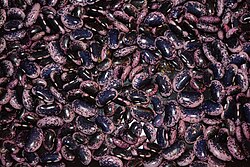Typical yield
1.2 t/ha
Varieties
1
Pest/Disease
6
Seasons
1
Profile
- Growth habit
- climber
- Lifecycle (days)
- 110–180
- Primary uses
- Pulse; vegetable (fresh pods); forage
- Pollination
- insect
- Origin / distribution
- Mesoamerican origin; adapted to cool highland tropics
Environment
Climate
Temp optimal
15–22 °C
Rain optimal
700–1200 mm/yr
Altitude
1200–2800 m
Soil
pH optimal
6–7
Soil type
Fertile, well-drained loam
Farmer Guide
Row spacing
90 cm
Plant spacing
45 cm
Depth
3 cm
Seed rate
50 kg/ha
Nursery days
Planting: Sow at onset of cool/wet season; provide sturdy trellis or poles.
Transplanting: Direct seed preferred; transplants may check growth.
Irrigation: Keep evenly moist; avoid drought at flowering and pod set.
Fertigation: Minimal N; focus on P and K; ensure molybdenum for nodulation where deficient.
Pest scouting: Scout for rusts and pod borers; maintain airflow; rotate fields.
Pruning/Training: Train vines up supports; remove excessive laterals if overcrowded.
Harvest: Pick fresh pods regularly; for dry seed, harvest when pods brown and seeds hard.
Postharvest: Dry grain to ≤12% moisture; store cool/dry; ventilate fresh pods.
Nutrient Schedule
| # | Stage | DAP | Product | Rate | Targets (kg/ha) | Notes |
|---|---|---|---|---|---|---|
| 1 | Basal | 0 | NPK 17-17-17 (light) or DAP+MOP | 60 kg/ha | N: —, P₂O₅: —, K₂O: — | Place away from seed to protect inoculant |
| 2 | Early pod set (if K low) | 40 | Sulfate of potash (SOP) | 40 kg/ha | N: —, P₂O₅: —, K₂O: 20 | Skip if soil K adequate |
Nutrient Requirements
| Nutrient | Stage | Amount | Unit |
|---|---|---|---|
| N | Basal | 0 | kg/ha |
| P₂O₅ | Basal | 25 | kg/ha |
| K₂O | Basal | 20 | kg/ha |
| N | Topdress | 0 | kg/ha |
| P₂O₅ | Topdress | 0 | kg/ha |
| K₂O | Topdress | 20 | kg/ha |
Images

| Name | Country | Maturity | Traits |
|---|---|---|---|
| Highland Runner | KE | 150 | Cool-tolerant vine; fresh or dry use |
| Stage | Product | Rate (kg/ha) | Notes |
|---|---|---|---|
| Basal | NPK 17-17-17 | 60 | Or equivalent P+K sources |
| Pod set | Sulfate of potash (SOP) | 40 | Apply only if K is deficient |
| Name | Type | Symptoms | Management |
|---|---|---|---|
| Rust | disease | Rusty pustules | Airflow; timely spray if needed |
| Rust (Uromyces spp.) | disease | Rusty pustules on leaves/stems | Resistant types; improved airflow; timely fungicides if severe |
| Angular leaf spot | disease | Angular lesions on leaves | Clean seed; rotation; residue management |
| Pod borers (Helicoverpa spp.) | pest | Feeding in flowers/pods | Flower–pod scouting; threshold-based control; timely picking |
| Aphids | pest | Curling leaves; honeydew | Conserve predators; control ants; soft insecticides if needed |
| Root rots (Pythium/Rhizoctonia) | disease | Damping-off; root lesions | Well-drained beds; seed treatment; avoid overwatering |
| System | Typical | Min | Max | Notes |
|---|---|---|---|---|
| rainfed highland | 1.2 | 0.6 | 2 | Higher with improved trellising and disease control |
| Country | Region | Planting | Harvest |
|---|---|---|---|
| KE | Highlands | Mar–Apr | Jul–Oct |
| Country | Region | Suitability |
|---|---|---|
| KE | Highlands | High |
